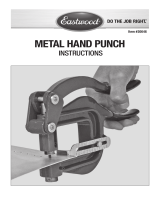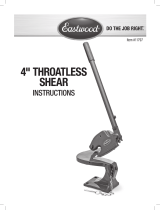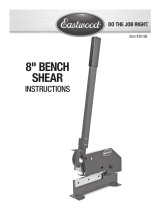Page is loading ...

ROTARY METAL SHEAR
INS TRUCTIONS
Item #20643

2 Eastwood Technical Assistance: 800.544.5118 >> techelp@eastwood.com
The EASTWOOD ROTARY METAL SHEAR is the perfect addition to any fabricators work bench. It is precision designed and manufactured to allow for quick and
easy trimming of sheet metal pieces and the rotary design allows for both straight and curved cuts. Hardened, round, cutting dies produce clean, burr-free cuts in
aluminum, steel and other mild metals.
CONTENTS
(1) Assembled Rotary Shear
(1) 9” Ratcheting Handle
SPECIFICATIONS
Maximum Material Cutting Thickness: 14 Gauge Aluminum, 16 Gauge Mild Steel
DANGER indicates a hazardous situation which, if not avoided, will result in death or serious injury.
WARNING indicates a hazardous situation which, if not avoided, could result in death or serious injury.
CAUTION used with the safety alert symbol, indicates a hazardous situation which, if not avoided, could result in minor or moderate injury.
NOTICE is used to address practices not related to personal injury.
READ INSTRUCTIONS
• Thoroughly read and understand this manual before using.
• Save for future reference.
INJURY HAZARD!
• This tool has EXTREMELY SHARP cutting dies which can quickly cause severe injury or loss of fingers! Keep fingers and hands away
from moving parts when operating.
• Wear thick, well fitting work gloves to prevent cuts from handling sharp metal.
• Frequently inspect cutting dies. If cracks or chips develop, discontinue tool use immediately.
• Always remove the handle from the tool when not cutting. The weight of the handle left in the up position can cause the upper die to
suddenly and unexpectedly rotate with great force resulting in severe injury or loss of fingers.
SAFETY INFORMATION
The following explanations are displayed in this manual, on the labeling, and on all other information provided with this product:

To order parts and supplies: 800.345.1178 >> eastwood.com 3
SET UP
Place the Shear on a clean, level surface at a comfortable working height. Mount
securely to the work surface using 2 suitable lag screws or bolts (not included)
through the two holes in the steel base (FIG 1).
CUT LAYOUT
For best accuracy it is recommended that you coat the cut area with layout fluid
or a marker and then scribe your cut line rather than using a marker (FIG 2). The
width of the scribe line will be much smaller and will provide a precise guide when
compared to the wide marker line.
OPERATION
1. Install ratcheting handle so that the upper die rotates when you pull the
handle towards yourself.
2. Apply moderate pressure to push the metal into the cutting dies as you pull
the handle towards you (FIG 3).
3. To ratchet the handle simply rotate the handle away from you. The handle
has an internal ratcheting mechanism that will re-engage automatically.
4. To make a curved cut, rotate the metal while it is fed into the dies.
NOTE: The Rotary Metal Shear creates its trim, the unwanted cut piece, on
the right. When cutting a curve make sure the unwanted portion is to the
right of the upper die (FIG 4).
STORAGE
• Remove handle to ensure that it cannot engage the upper cutting die in
storage.
• Apply a thin film of light oil or rust-preventive coating to all bare steel areas.
• Store in a clean, dust-free, dry, dampness free area preferably covered with
plastic sheeting.
MAINTENANCE
NOTE: Maintenance should be performed before each use.
• Check tightness of all hardware.
• Check operation for binding. Lubricate Pivot Points and Dies periodically with
a medium bodied lubricating oil.
Always keep the handle removed from the tool when not
cutting. The weight of the handle can cause the upper die
to suddenly and unexpectedly rotate.
FIG. 1
The cutting dies are extremely sharp! Use extreme care
when operating to avoid severe cuts or loss of fingers!
The cutting dies are extremely sharp! Use extreme care
when operating to avoid severe cuts or loss of fingers!
FIG. 2
FIG. 3
FIG. 4

© Copyright 2016 Easthill Group, Inc. 6/16 Instruction Item #20643Q Rev. 0
If you have any questions about the use of this product, please contact
The Eastwood Technical Assistance Service Department: 800.544.5118 >> email: techelp@eastwood.com
PDF version of this manual is available online >> eastwood.com/20643manual
The Eastwood Company 263 Shoemaker Road, Pottstown, PA 19464, USA
US and Canada: 800.345.1178 Outside US: 610.718.8335
Fax: 610.323.6268 eastwood.com
PROBLEM CAUSE CORRECTION
Rotary Metal
Shear Does
Not Cut
Incorrect Handle Orientation
Ensure that the Upper Die is turning as you pull the handle towards you. If it is
not, remove handle and re-install in the opposite orientation.
Tool Body Has Flexed and Cutting Dies
are on Top of One Another
Remove the Hex Nut fastening the Upper Cutting Die, remove Die and re-install
in the correct configuration. Cutting edges should be beside one another.
Upper Die is Spinning Freely Moderate pressure is required to feed the metal into the Dies.
ADDITIONAL AVAILABLE ITEMS
#12012 Mig 175
#14042 Versa Bend Sheet Metal Brake
#13603 Auto body Sheet Metal Kit 20 Gauge Aluminized Steel
#11797 Throatless Shear
#20198 8” Bench Shear
TROUBLESHOOTING
/







